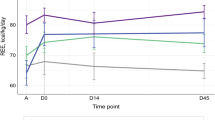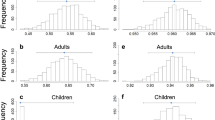Abstract
Background: A knowledge of energy expenditure in infancy is required for the estimation of recommended daily amounts of food energy, for designing artificial infant feeds, and as a reference standard for studies of energy metabolism in disease states.
Objective: The objectives of this study were to construct centile reference charts for total energy expenditure (TEE) in infants across the first year of life.
Methods: Repeated measures of TEE using the doubly labeled water technique were made in 162 infants at 1.5, 3, 6, 9 and 12 months. In total, 322 TEE measurements were obtained. The LMS method with maximum penalized likelihood was used to construct the centile reference charts. Centiles were constructed for TEE expressed as MJ/day and also expressed relative to body weight (BW) and fat-free mass (FFM).
Results: TEE increased with age and was 1.40,1.86, 2.64, 3.07 and 3.65 MJ/day at 1.5, 3, 6, 9 and 12 months, respectively. The standard deviations were 0.43, 0.47, 0.52,0.66 and 0.88, respectively. TEE in MJ/kg increased from 0.29 to 0.36 and in MJ/day/kg FFM from 0.36 to 0.48.
Conclusions: We have presented centile reference charts for TEE expressed as MJ/day and expressed relative to BW and FFM in infants across the first year of life. There was a wide variation or biological scatter in TEE values seen at all ages. We suggest that these centile charts may be used to assess and possibly quantify abnormal energy metabolism in disease states in infants.
This is a preview of subscription content, access via your institution
Access options
Subscribe to this journal
Receive 12 print issues and online access
$259.00 per year
only $21.58 per issue
Buy this article
- Purchase on Springer Link
- Instant access to full article PDF
Prices may be subject to local taxes which are calculated during checkout






Similar content being viewed by others
References
Butte NF (1996): Energy requirements of infants. Eur. J. Clin. Nutr. 50(Suppl 1), S24–S36.
Butte NF, Wong WW, Hopkinson JM, Heinz CJ, Mehta NR & O'Brian Smith E (2000): Energy requirements derived from total energy expenditure and energy deposition during the first 2 years of life. Am. J. Clin. Nutr. 72, 1558–1569.
Cole TJ (1990): The LMS method for constructing normalized growth standards. Eur. J. Clin. Nutr. 44, 45–60.
Cole TJ & Green PJ (1992): Smoothing reference centile curves: the LMS method and penalized likelihood. Stat. Med. 11, 1305–1319.
Davies PSW (1996): Total energy expenditure in young children. Am. J. Hum. Biol. 8, 183–188.
Davies PSW (1998): Energy requirements for growth and development in infancy. Am. J. Clin. Nutr. 68, 939S–943S.
Davies PSW, Ewing G & Lucas A (1989): Energy expenditure in early infancy. Br. J. Nutr. 62, 621–629.
de Bruin NC, Degenhart HJ, Gal S, Westerterp KR, Stijnen T & Visser HKA (1998): Energy utilization and growth in breast-fed and formula-fed infants measured prospectively during the first year of life. Am. J. Clin. Nutr. 67, 885–896.
Fomon SJ, Haschke F, Ziegler EE & Nelson SE (1982): Body composition of reference children from birth to age 10 years. Am. J. Clin. Nutr. 35, 1169–1175.
Jones PJH, Winthrop AL, Schoeller DA, Swyer PR, Smith J, Filler RM et al. (1987): Validation of doubly labelled water for assessing energy expenditure in infants. Pediatr. Res. 21, 242–246.
Lucas A, Ewing G, Roberts S & Coward W (1987): How much energy does the breast fed infant consume and expend? BMJ 295, 75–77.
Prentice AM, Lucas A, Vasquez-Velasquez L, Davies PSW & Whitehead RG (1988): Are current dietary guidelines for young children a prescription for overfeeding? Lancet 2, 1066–1069.
Roberts SB, Coward WA, Schlingenseipen KH, Nohria V & Lucas A (1986): Comparison of the doubly labelled water method with indirect calorimetry and a nutrient balance study for simultaneous determination of energy expenditure, water intake and metabolizable energy intake in preterm infants. Am. J. Clin. Nutr. 44, 315–322.
Roberts SB, Savage J, Coward WA, Chew B & Lucas A (1988): Energy expenditure and intake in infants born to lean and overweight mothers. N. Engl. J. Med. 318, 461–466.
Stunkard AJ, Berkowitz R, Stallings VA & Schoeller DS (1999): Energy intake, not energy output, is a determinant of body size in infants. Am. J. Clin. Nutr. 69, 524–530.
Vasquez-Velasquez L (1988): Energy expenditure and physical activity of malnourished Gambian infants. Proc. Nutr. Soc. 47, 233–239.
Wells JCK & Davies PSW (1995): Estimation of the energy cost of physical activity in infancy. Arch.Dis. Child 78, 131–136.
Wells JCK & Davies PSW (1996): Relationship between behavior and energy expenditure in 12-week-old infants. Am. J. Hum. Biol. 8, 465–472.
Wells JCK & Davies PSW (1998): Estimation of the energy cost of physical activity in infancy. Arch. Dis. Child 78, 131–136.
Whitehead RG, Paul AA & Cole TJ (1981): A critical analysis of measured food energy intakes during infancy and early childhood in comparison with current international recommendations. J. Hum. Nutr. 35, 339–348.
World Health Organisation (1985). Energy and protein requirements. Report of a joint FAO/WHO/UNU expert consultation. Geneva: World Health Organisation.
Acknowledgements
We gratefully acknowledge the families and infants who so generously volunteered their time for this research. This study was supported in part by a grant from the National Health and Medical Research Council of Australia. We also acknowledge the support of the Royal Children's Hospital Foundation, Brisbane. Australia.
Author information
Authors and Affiliations
Contributions
Guarantor: PSW Davies.
Contributors: CAR wrote the paper, interpreted the results, performed statistical analysis and maintained the Australian cohort, PSWD supervised the writing of the paper and interpretation of results and co-maintained the UK cohort, JCKW co-maintained the UK cohort, and LMA performed TEE analysis for the Australian cohort, and GC and RWS co-supervised the Australian study. All contributors edited the final draft of the paper.
Corresponding author
Rights and permissions
About this article
Cite this article
Reichman, C., Davies, P., Wells, J. et al. Centile reference charts for total energy expenditure in infants from 1 to 12 months. Eur J Clin Nutr 57, 1060–1067 (2003). https://doi.org/10.1038/sj.ejcn.1601642
Received:
Revised:
Accepted:
Published:
Issue Date:
DOI: https://doi.org/10.1038/sj.ejcn.1601642



